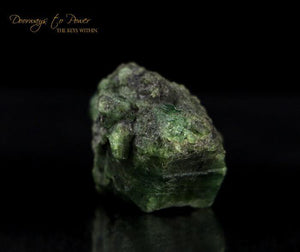Your Cart is Empty








Sold out
Rare Russian Alexandrite Crystal 'Duality' A+++
$ 508.30$ 598.00
Alexandrite is a very rare and highly valuable gemstone, and until recently was extremely difficult to obtain due to its rarity.
Perhaps the first person to attribute alexandrite with magical powers was the Russian writer Nikolai Semyonovich Leskov (1831-1895) who wrote a short novel, "Alexandrite, Mysterious Interpretation of a True Fact", in which the gem plays a major role and is defined as a prophetic stone. At nearly the same time, Eliphas Levi, a French author and magician (1810 -1875), connected the duality of the colors in alexandrite with the duality of human blood -- venous and arterial. In his book, La Clef des Grandes Mysteres (The Key to the Great Mysteries), he refers to alexandrite as "the favorite charm of our time which clears and strengthens the blood vessels".
It isn't surprising that various magical attributes have been associated with alexandrite. Such a rare and valuable gem with a mysterious origin was unlikely to be ignored when the connection of gemstones with different months or astrological signs had already been accepted for more than 2000 years. Many cultures associate gems with the signs of the zodiac or months of the year and are thought to be lucky or important for people born under their influence. The tradition of birthstones first became popular in the Middle Ages, but probably started much earlier.
Dimensions: .84" x 1.11" x .84" inches
Weight: 90 carats
At first, there were two ways in which a gemstone could become associated with a person's month of birth. The first was through Biblical references. The Talmud mentions the use of precious stones as talismans. Sometime around 200 AD, the historian Josephus described a connection between the months of the year and the breastplate of the high priest in the Great Temple in Jerusalem. The external part of the breastplate was set with four rows of gems, three in each row, each engraved with the name of one of the twelve tribes of Israel. (Exodus xxviii, 17-20.) The names of these stones are generally agreed to be:
n Indian, or Vedic, astrology, each stone is associated with a planet, a day of the week, a time of day, and various other attributes associated with that planet. Alexandrite is associated with the planet Mercury -- the trickster. Alexandrite's ability to change color and its obviously dual nature is further associated with the zodiac sign of Gemini, which is a sign ruled by Mercury. The association with the sign of Gemini means that Alexandrite has a connection with the month of June as this sign covering the period between 21st May and 21st June. In Russia, Alexandrite is associated with the month of August, and it's zodiac sign Leo is related to royalty.
In Indian, or Vedic, astrology, each stone is associated with a planet, a day of the week, a time of day, and various other attributes associated with that planet. Alexandrite is associated with the planet Mercury -- the trickster. Alexandrite's ability to change color and its obviously dual nature is further associated with the zodiac sign of Gemini, which is a sign ruled by Mercury. The association with the sign of Gemini means that Alexandrite has a connection with the month of June as this sign covering the period between 21st May and 21st June. In Russia, Alexandrite is associated with the month of August, and it's zodiac sign Leo is related to royalty.
When choosing an individual's gemstone in India and in using gems for magic, the associations and correspondences with the planet Mercury are considered in detail. Mercury is the fastest moving of the planets. It shows how quickly we can change our thoughts, and how fast our thoughts travel. In occult thought, Mercury represents both the messenger and the magician. It connects the mortal or ego self, the intuitive, or lower self, and the higher divine self. As Mercury is associated with air, alexandrite is an air stone and so connected to the throat chakra. But, because of its duality in color, it has also been associated with the heart, the solar plexus, and the crown chakra.
Mercury also represents the power of the mind, our ability to think, perceive, and communicate and it rules over the power of our words and how we use them. It is the planet most associated with the rational world. In magic, alexandrite can be used alongside other Mercury ruled objects to cast spells that enhance communication, mental clarity, memory, and perception. It can be used in meditation, to promote emotional balance, and to bring about change, happiness, and success. It is thought to be most powerful when the sun's rays are shining on it and is reportedly useful for astral travel.
The caduceus symbol used for doctors and medicine is also a Mercury symbol and Mercury is associated with healing and was originally the god of medicine. Therefore, alexandrite is a healing stone.
Dreams of alexandrite are said to symbolize struggle and progress. In Kabbalistic magic, alexandrite is associated with Zain, or the seventeenth path of the Tree of Life. It connects Spiritual Love and the centered self. In the Tarot, alexandrite is associated with the Lovers, the card that is connected with choice. The Avesty's astrological school consider alexandrite as a stone for spirituality where the owners of the stone must be prepared to overcome hardship after which alexandrite will bring calm, luck, and victory.
Alexandrite is the stone of duality. Green or red, good luck or misfortune, the significance is interpretive and related to the social and historical context of the time and the culture. Forever changing its colors, alexandrite is a magical gemstone with universal appeal that continues to fascinate and be admired by astrologers, scientists, and gem lovers throughout the world.








